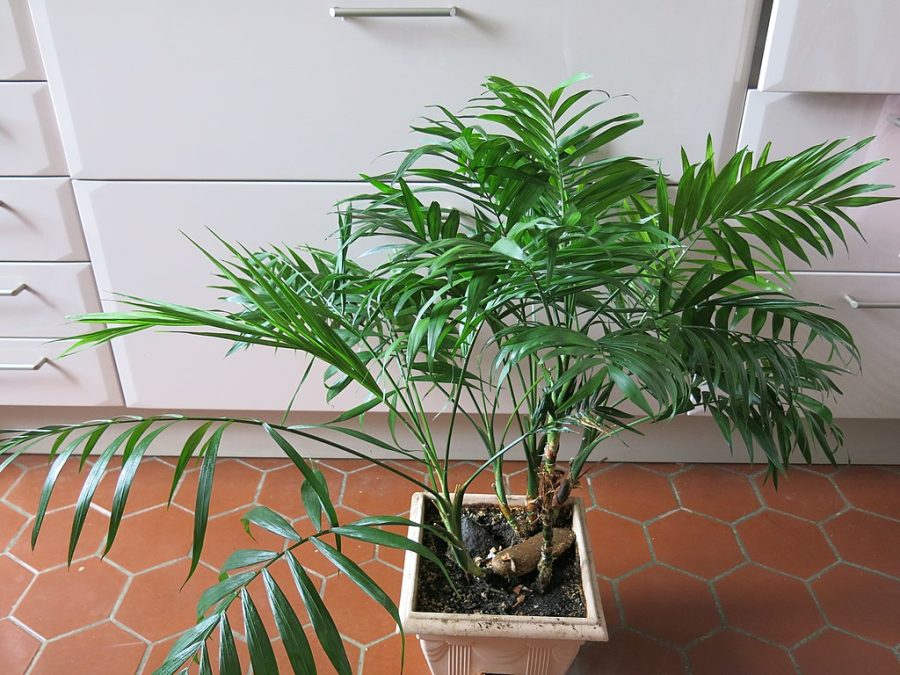This post contains affiliate links. If you buy something from one of our links we may earn a commission. Thanks

Get tips on Parlor Palm indoor care (Chamaedorea elegans) with our complete indoor care guide! Learn about light, watering, repotting, and more.
Parlor Palm indoor care (Chamaedorea elegans) care entails watering every two weeks or when the top soil layer begins to dry, providing bright but indirect sunlight, and maintaining a temperature between 64ºF and 75ºF.
Utilize porous sandy soil with low nutrient composition and an alkaline pH for optimal growth. This plant is forgiving and demands less time and energy, making it a convenient choice for indoor greenery.
Looking for a low-maintenance and stylish indoor plant?
The Parlor Palm plant (Chamaedorea elegans) might just be a great addition to your home or office.
With its lush green leaves and air-purifying qualities, this tropical plant is a great way to freshen up any space.
However, to keep your Parlour Palm healthy and thriving, it’s important to know how to care for it properly.
In this complete guide, we’ll cover everything you need to know about Parlor Palm indoor care, including lighting, watering, fertilizing, repotting, and more.
According to Wikipedia: Chamaedorea elegans, the neanthe bella palm or parlour palm, is a species of small palm tree native to the rainforests in Southern Mexico and Guatemala. The parlor palm is one of the most extensively sold houseplant palms in the world.
So, let’s get started!
Parlor Palm Indoor Care Instructions In A Nutshell
Welcome to the ultimate guide on Parlor Palm care!
Looking for a Parlor Palm? Get one on Amazon
Whether you’re a new plant owner or a seasoned gardener, this guide will provide you with all the information you need to keep your Parlor Palms healthy and thriving.
In this section, we will briefly cover all the necessary care instructions for your plant, including watering, fertilizing, lighting, and more.
By following these instructions, you’ll be able to enjoy the beauty of your Parlor Palms for years to come. Let’s get started!
Basic care instructions checklist:
• Lighting: Parlor Palms prefer bright, indirect light but can also tolerate low light conditions. Avoid direct sunlight as it can scorch the leaves.
• Watering: Allow the top inch of soil to dry out before watering. Water thoroughly and ensure good drainage to prevent overwatering.
• Fertilizing: Use a balanced fertilizer once a month during the growing season, spring to fall. Use a slow-release fertilizer spike for a more convenient option.
• Temperature and Humidity: Parlor Palms thrive in temperatures between 60-80°F (15-27°C) and high humidity. Mist the leaves regularly or use a humidifier to increase humidity levels.
• Soil and Repotting: Use a well-draining, peat-free soil mix and repot every two years, or when the roots outgrow the pot.
• Pruning: Remove any dead or yellowing leaves and trim the tips of the plant to control its size.
• Pests and Diseases: Keep an eye out for common pests such as spider mites and mealybugs, and treat them promptly. Avoid overwatering to prevent root rot and other fungal diseases.
Remember to regularly check your Parlor Palm for any signs of problems and adjust your care routine accordingly.
With proper care, your Parlor Palm can thrive and make a beautiful addition to your home.
Parlor Palm Indoor Benefits
Parlor Palms are a popular indoor plant for a reason – not only do they add a touch of tropical elegance to any room, but they also provide a range of benefits.
From purifying the air to reducing stress levels, Parlor Palms are an excellent addition to any home or office space.
In this blog post, we’ll explore the different benefits of Parlor Palms, and why you should consider adding one to your indoor plant collection.
Air Purification and Stress Reduction:
Parlor Palms have numerous benefits when kept indoors.
They are known for their ability to purify the air by removing toxins and impurities.
In addition, they have been shown to help reduce stress and create a calming environment.
Ideal Locations:
When deciding where to keep your Parlor Palm, it’s important to consider their ideal living conditions.
They thrive in bright, indirect sunlight and warm temperatures.
They can be placed in living rooms, bedrooms, and even offices as long as they are not in direct sunlight.
Additional Benefits:
Parlor Palms are low-maintenance plants and can help to create a relaxing and aesthetically pleasing environment in any space.
They are also great for people who suffer from allergies or asthma, as they have been shown to reduce airborne allergens.
How to Care for a Parlor Palm
Parlor Palms are easy to care for and make great indoor plants.
They are popular because of their elegant look, compact size, and low maintenance.
In this post, we will cover everything you need to know about caring for a Parlor Palm, from watering and fertilizing to repotting and pruning.
We will also discuss common problems and how to prevent them, as well as the benefits of having a Parlor Palm in your home or office.
So, let’s dive in and learn how to care for your Parlor Palm!
Ideal conditions: Parlor Palms thrive in bright, indirect light and temperatures between 65-80°F. They also prefer moderate humidity levels.
Watering and fertilizing tips: Water the plant when the top inch of soil is dry, and avoid overwatering or underwatering.
Use a balanced fertilizer every 2-3 months during the growing season.
Repotting and propagation instructions: Repot the plant every 2-3 years in fresh soil, and propagate through division or rooting in water or soil.
Troubleshooting: Watch out for brown tips, pests, and brown spots and other diseases, and take appropriate action to address these issues.
Additional tips: Dust the leaves regularly, keep the plant away from drafts, and provide it with occasional misting or a shower to improve humidity levels.
Chamaedorea Elegans Size, Growth Rate, and Common Name
Chamaedorea elegans, also known as the Parlor Palm, is a popular houseplant that adds a touch of tropical elegance to any space.
While it may be small, this plant is mighty!
In this post, we’ll take a closer look at the size, growth rate, and common name of the Chamaedorea elegans.
We’ll explore how these factors impact the plant’s care needs and how you can ensure your Parlor Palm thrives in your home or office. So, let’s get started!
Common name: Parlor Palm
The Chamaedorea elegans is commonly known as the Parlor Palm, as it was a popular indoor plant in the Victorian era and graced many a parlor with its lush foliage.
Size and Growth Rate:
The Parlor Palm is a slow-growing plant that typically reaches a height of 2-6 feet when fully mature.
Its slender stems hold up to 10-12 arching, feathery fronds, each up to 2-3 feet long. The plant grows slowly and takes several years to reach its full height.
Benefits of Slow Growth:
The slow growth rate of the Parlor Palm means that it doesn’t need to be repotted as frequently as other houseplants, making it an excellent low-maintenance option for busy plant owners.
Its compact size and slow growth also make it ideal for smaller spaces or as an accent plant in larger areas.
Parlor Palm (Chamaedorea elegans) is a small, slow-growing plant native to Mexico and Central America.
It is known for its delicate yet attractive appearance, making it a popular choice for indoor decoration.
The plant features thin, feathery fronds and mature plants can grow up to 4 feet tall, creating a lush tropical vibe in any space.
While the Parlor Palm is a hardy plant that can tolerate low light and dry air, proper care is still essential for its survival and growth.
Neglecting the plant’s needs can cause it to develop problems such as brown leaf tips, leaf drop, and pests, which can ultimately lead to its demise.
Providing the right conditions and care is crucial for keeping your Parlor Palm healthy and thriving.
In the following sections, we will cover different aspects of Parlor Palm care in detail, including lighting requirements, soil and pot size, watering, fertilizing, repotting, and propagation.
We will also discuss common problems that Parlor Palms may face and how to prevent and treat them.
By the end of this guide, you’ll have all the information you need to care for your Parlor Palm and enjoy its beauty for years to come.
Parlor Palm Light Requirements
When it comes to caring for your Parlor Palm (Chamaedorea elegans), understanding its light requirements is crucial.
Like most indoor plants, the Parlor Palm’s growth and health are highly dependent on the amount of light it receives.
However, this tropical plant has specific light needs that can differ from other species, and providing the right amount of light can be a bit of a balancing act.
In this section, we’ll explore the Parlor Palm’s light requirements in detail, including how much light it needs, what type of light it prefers, and how to ensure it gets enough without overdoing it.
With these tips, you can keep your Parlor Palm healthy and thriving for years to come.
Ideal lighting conditions for Parlor Palms
The Parlor Palm thrives in bright indirect light.
It prefers a spot near a window where it can receive plenty of bright, filtered light without being exposed to direct sunlight.
Direct sunlight can burn the leaves, while too little light can cause the plant to become leggy and lose its lush appearance.
Aim for a location that receives 4-6 hours of bright, indirect light per day.
Effects of too much light
While the Parlor Palm prefers bright light, too much direct sunlight can cause damage to the plant.
If the plant is exposed to direct sunlight for an extended period, its leaves can develop brown, crispy spots or even burn.
If you notice that your Parlor Palm’s leaves are turning yellow, try moving it to a more shaded area.
Effects of too little light
On the other hand, too little light can also be detrimental to the plant’s growth and health.
If the Parlor Palm doesn’t receive enough light, it can become weak and leggy, with sparse and undersized leaves.
In severe cases, the plant may stop growing altogether or even die.
If you notice that your Parlor Palm isn’t getting enough light, try moving it to a brighter location or providing supplemental artificial light.
In conclusion, it’s essential to provide the right amount and type of light to your Parlor Palm for optimal growth and health.
With bright, indirect light and proper care, your Parlor Palm can thrive and bring a tropical feel to any space.
Soil and Pot Size
Hey there, fellow plant lover! Now that you know about Parlor Palm’s light requirements, it’s time to move on to the next crucial aspect of caring for your plant – soil, and pot size.
The type of soil and pot you choose can significantly impact your Parlor Palm’s growth and health.
In this section, we’ll cover everything you need to know about soil and pot size for your Parlor Palm.
We’ll discuss the ideal soil mix, pot size, and drainage requirements to ensure your plant has the best growing conditions.
By the end of this section, you’ll be a pro at choosing the right soil and pot for your Parlor Palm.
Ideal soil type for Parlor Palms
The Parlor Palm prefers a well-draining, nutrient-rich soil mix.
A good soil mix for this plant should be able to hold moisture without becoming waterlogged.
A combination of peat moss, perlite, and sand or vermiculite is a good choice.
Alternatively, you can use a mix of coco coir and perlite as an eco-friendly and sustainable alternative to peat moss or peat-based soil mixes.
Coco coir is a byproduct of coconut husks and is renewable and biodegradable.
It has excellent water retention and aeration properties, making it an excellent choice for Parlor Palms.
Ideal pot size for Parlor Palms
The ideal pot size for your Parlor Palm depends on its current size and growth rate.
As a general rule, choose a pot that’s one size larger than the plant’s current pot.
This will give the roots room to grow and prevent the soil from drying out too quickly. A pot that’s too large can lead to waterlogged soil and root rot.
Importance of good drainage and aeration
Good drainage and aeration are crucial for your Parlor Palm’s health.
If the soil doesn’t drain well or has poor aeration, the roots can become waterlogged and begin to rot from too much water.
To ensure good drainage and aeration, choose a pot with drainage holes in the bottom and use a soil mix that allows air to flow freely through the soil.
In conclusion, choosing the right soil and pot size is essential for the health and growth of your Parlor Palm.
Whether you choose a peat-based mix or an eco-friendly alternative like coco coir and perlite, make sure it’s well-draining and nutrient-rich.
With the right pot size and good drainage and aeration, you can ensure your plant has the best growing conditions. Happy potting!
How to Make Parlor Palm Grow Faster
Parlor Palms are slow-growing plants, and while this can be a desirable trait, some plant owners may want to speed up the growth process.
If you’re looking for ways to encourage your Parlor Palm to grow faster, you’re in luck!
There are a few simple things you can do to give your plant the best chance to thrive and grow.
Keep reading to learn some tips on how to make your Parlor Palm grow faster.
Repotting
One way to encourage faster growth in your Parlor Palm is to repot it every couple of years.
As the plant grows, its roots will begin to outgrow the pot, and repotting will give the roots more room to spread out and absorb nutrients.
When repotting, choose a pot that’s one size larger than the current pot, and use a well-draining soil mix to ensure good root health.
Pruning
Pruning your Parlor Palm can also encourage faster growth.
Removing dead or damaged fronds can help redirect the plant’s energy to new growth.
You can also remove any side shoots that appear at the base of the plant to encourage vertical growth.
Be sure to use clean and sharp tools to avoid damaging the plant.
Nutrients and care
Providing the right nutrients and care is crucial for promoting growth in your Parlor Palm.
Fertilize your plant with a balanced, water-soluble fertilizer every two to four weeks during the growing season.
Water your plant regularly, but make sure not to overwater, as this can lead to root rot.
Keep your plant in a location with bright, indirect light, and maintain a consistent temperature and humidity level.
In conclusion, if you want to encourage faster growth in your Parlor Palm, repotting, pruning, and providing the right nutrients and care are all important factors.
By taking the time to give your plant the best growing conditions, you can help it thrive and reach its full potential.
Parlor Palm Brown Tips
One of the most common problems that Parlor Palm owners face is the development of brown tips on the leaves.
While this can be frustrating, it’s not an uncommon issue, and there are a few things you can do to address it.
In this section, we’ll explore the various causes of brown tips on Parlor Palms and offer some tips on how to prevent and treat this issue.
Keep reading to learn more!
Possible causes
There are a few reasons why brown tips might develop on your Parlor Palm’s leaves.
Overwatering is a common culprit, as it can cause the roots to rot and prevent the plant from absorbing nutrients properly.
Alternatively, dry air can also cause brown tips, as the plant loses moisture through its leaves.
Exposure to direct sunlight, harsh chemicals, and low humidity can also lead to brown tips.
Prevention
To prevent brown tips from developing, it’s important to keep your Parlor Palm healthy and in a suitable environment.
Avoid overwatering your plant and ensure that it’s not sitting in standing water.
Use filtered or distilled water, as tap water can contain chemicals that are harmful to your plant.
Keep your plant away from direct sunlight and protect it from cold drafts.
You can also increase humidity levels around your plant by using a humidifier, placing it on a pebble tray, or placing a tray of water near it.
Treatment
If you notice brown tips on your Parlor Palm, you can take steps to treat the issue.
First, remove any affected leaves by cutting them off at the base of the stem.
This will prevent further damage and allow the plant to focus on healthy growth.
If the brown tips are caused by dry air, increase the humidity around your plant as described above.
If overwatering is the issue, allow the soil to dry out before watering again.
You can also try repotting your plant with fresh soil to promote healthy growth.
In conclusion, brown tips on Parlor Palms can be caused by a variety of factors, but with proper prevention and treatment, you can keep your plant healthy and free of damage.
By identifying the cause of the issue and taking steps to address it, you can ensure that your Parlor Palm thrives and continues to brighten up your indoor space.
Parlor Palm Problems
Parlor Palms (Chamaedorea elegans) are generally easy-going indoor plants, but sometimes they can encounter problems.
In this section, we’ll discuss the most common problems that Parlor Palms face, such as yellowing leaves, pests, and more.
We’ll also cover how to identify and resolve these issues to keep your Parlor Palm healthy and happy.
Pest problems:
Parlor Palms are susceptible to mealybugs, spider mites, and scale.
These pests can weaken the plant and make it more susceptible to disease.
To prevent and treat pest problems, regularly inspect your plant and isolate it from other plants if you notice any signs of infestation.
You can also wipe the leaves with a damp cloth to remove any visible pests. For more serious infestations, use insecticidal soap or neem oil.
Disease problems:
Overwatering and poor drainage can cause root rot, which can lead to yellowing leaves and stunted growth.
Fungal diseases can also cause leaf spotting and discoloration.
To prevent and treat disease problems, make sure your Parlor Palm is in well-draining soil and that you’re not overwatering it.
If you notice any signs of disease, isolate the plant and remove any affected leaves. You can also use a fungicide to treat more serious fungal infections.
Environmental problems:
Parlor Palms are sensitive to environmental changes such as temperature fluctuations and low humidity.
Low light conditions can also cause yellowing leaves and stunted growth.
To prevent and treat environmental problems, keep your Parlor Palm in a spot with consistent temperatures and moderate humidity levels.
Make sure your plant is getting enough light, but not too much direct sunlight. Rotate your plant occasionally to ensure even growth.
Parlor Palm Size
Parlor Palms, also known as Chamaedorea elegans, are a popular indoor plant due to their compact size and low maintenance needs.
Despite their small stature, Parlor Palms can reach impressive heights if given proper care.
In this section, we’ll explore the various factors that contribute to the size of Parlor Palms and how you can encourage healthy growth.
Typical Parlor Palm Size
Parlor Palms typically grow to a height of 4-6 feet in their natural habitat.
However, indoor-grown Parlor Palms can be kept much smaller through proper care.
Controlling Parlor Palm Growth
To keep your Parlor Palm at a manageable size, you can control its growth through various methods.
Repotting is an effective way to control the size of your plant as it restricts the amount of space the roots have to grow, limiting the size of the plant.
Another method is pruning, which involves trimming back the leaves and stems of the plant to keep it at a desired height.
Repotting and Pruning Parlor Palms
When repotting these indoor palms, it’s important to choose a pot that is only slightly larger than the current one to restrict the plant’s growth.
The parlor palm is a slow grower and does not need repotting often.
Pruning should be done in the spring when the plant is actively growing.
Trim back any yellow or brown leaves and cut back the top of the stem to the desired height.
Be sure to use clean and sharp pruning tools to avoid damaging the plant.
Parlor Palm Fruit
Have you ever wondered if your Parlor Palm (Chamaedorea elegans) can bear fruit?
While this indoor plant is popular for its lush green foliage, it can also produce small, black fruit under the right conditions.
In this section, we’ll discuss what to expect from Parlor Palm fruit and how to care for your plant to encourage fruiting.
Description of Parlor Palm fruit
The Parlor Palm produces small, dark-colored fruits that contain seeds. These fruits typically grow in clusters and can add an interesting visual element to the plant.
Significance of Parlor Palm fruit
While the fruit of the Parlor Palm is not typically the main reason people grow the plant, it is a notable feature that can add interest and texture to the plant’s appearance.
The fruit also serves as a natural method of reproduction for the plant, as the seeds can be collected and planted to grow new Parlor Palms.
Care for Parlor Palm fruit production
To encourage the Parlor Palm to produce fruit, ensure that the plant is receiving proper care in terms of light, water, and nutrients.
Additionally, providing appropriate humidity levels can help to promote healthy fruit development.
Edibility of Parlor Palm fruit
While the fruit of the Parlor Palm is not typically grown for consumption, it is not considered toxic and is safe for humans and pets to consume in small quantities.
However, it is not known for its taste, so it is unlikely to be a popular food item.
Parlor Palm Watering
Keeping your Parlor Palm (Chamaedorea elegans) well-watered is essential for its health and growth.
However, too much or too little water can cause serious problems for this popular indoor plant.
In this section, we’ll discuss the ideal watering schedule and techniques for Parlor Palms, as well as how to identify and address issues related to overwatering or underwatering.
Let’s dive in!
Proper watering technique
To keep your Parlor Palm healthy, it’s important to water it properly.
Overwatering or underwatering can harm the plant, so finding the right balance is key.
As a general rule, you should water your Parlor Palm when the top inch of soil feels dry to the touch.
Checking the plant’s moisture level
To check the soil moisture level, stick your finger into the soil up to the second knuckle.
If the soil feels dry at this depth, it’s time to water the plant. If the soil still feels moist, wait a few days and check again.
Avoiding tap water
It’s best to avoid using tap water to water your Parlor Palm.
Tap water can contain chemicals, such as chlorine and fluoride, that can be harmful to the plant.
Instead, use distilled water or collect rainwater to water your plant.
Parlor Palm Fertilizer
If you want your Parlor Palm to thrive, providing it with the right nutrients is essential.
Fertilizing your plant can help it grow stronger and healthier, but it’s important to do it correctly.
In this section, we’ll discuss everything you need to know about fertilizing your Parlor Palm, including the best type of fertilizer to use, when and how to apply it, and how to avoid over-fertilization.
Let’s get started!
Type and Frequency of Fertilizer
Parlor Palms, like many houseplants, benefit from regular fertilization to support healthy growth.
Choose a balanced fertilizer to ensure the plant receives all the necessary nutrients.
Apply the fertilizer every four to six weeks during the growing season (spring and summer months).
During the dormant period (fall and winter), reduce fertilization to once every two to three months.
Benefits of Fertilizer
Fertilizers can help to promote healthy growth, improve the plant’s resilience, and enhance its overall appearance.
The right balance of nutrients helps the Parlor Palm produce lush green foliage and stronger roots, which can better absorb water and nutrients.
A well-fed plant can also better resist pests and diseases.
Slow-Release Fertilizer Spikes
If you’re looking for a convenient and low-maintenance way to fertilize your Parlor Palm, consider using slow-release fertilizer spikes.
These spikes are inserted into the soil, where they release nutrients over several months.
They’re a great option if you’re busy or forgetful and want to ensure your plant is getting the right nutrients consistently.
Just remember to replace the spikes every few months to keep the fertilizer supply consistent.
The use of tree spikes will take the guesswork out of fertilizing. Here is what I recommend for  fertilizing your parlor palm.
fertilizing your parlor palm.
I recommend using Jobes Organics fertilizer spikes.
They are easy to use and last for 2-3 months.
They are designed for container-grown citrus. They also work really well for container-grown palms.
Using 2 spikes for a 12-inch pot or 3 for an 18-inch pot takes the guesswork out of fertilizing.
They provide a 3-5-5 fertilizer blend along with micronutrients and beneficial bacteria.
Repotting and Propagation
If your Parlor Palm has outgrown its pot or you want to propagate new plants, repotting and propagation can be a fun and rewarding experience.
In this section, we’ll discuss how to successfully repot your Parlor Palm, including when to do it and what soil and pot to use.
We’ll also cover different propagation methods, including how to propagate from seeds or cuttings, so you can grow new Parlor Palms and expand your indoor jungle.
Repotting Parlor Palms:
As your Parlor Palm grows, you’ll need to repot it to a larger pot to provide more room for its roots.
In this section, we’ll discuss when and how to repot your plant to ensure its continued growth and health.
Propagating Parlor Palms:
Propagation is the process of creating new plants from an existing parent plant.
In this section, we’ll explain how to propagate your Parlor Palm using methods such as division and rooting offsets in soil.
Whether you want to expand your collection or share your plant with a friend, propagation is a great way to keep your Parlor Palm thriving.
How to propagate Parlor Palms
Propagating Parlor Palms is an excellent way to increase your plant collection or share your love for these beautiful plants with others.
There are several methods of propagation, including division and growing from seeds.
Division
Division is a straightforward process that involves separating the plant into smaller sections and planting them separately.
Offsets
Finally, rooting offsets in soil involves taking cuttings at the base of the mother plant and planting them directly in the soil.
Growing with seeds
You can grow a Parlor Palm from seeds if your plant produces them. If not you can buy seeds online. Be patient this can take a long time.
In this method, it’s crucial to keep the soil moist and provide proper lighting and humidity to encourage root growth.
With a little patience and the right care, you can easily propagate your Parlor Palms and enjoy the benefits of having more of these beautiful plants in your home.
Parlor Palm FAQs
Caring for a Parlor Palm (Chamaedorea elegans) is generally straightforward but certain common concerns may arise.
It’s normal to have questions especially if you are new to indoor gardening.
Below are some frequently asked questions along with their answers to help you better understand the care, potential issues, and growth expectations of your Parlor Palm. Whether it’s about yellowing leaves or the rate at which your palm grows, we’ve got some insights for you.
Q. Why is my parlor palm turning yellow?
A. Overwatering or insufficient light may cause yellowing. Ensure proper watering and place it in bright, indirect sunlight.
Q. Should I cut off brown palm leaves?
A. Yes, trim brown leaves to encourage new growth and maintain aesthetics.
Q. Can yellow palm leaves turn green again?
A. It’s difficult for yellow leaves to turn green again, addressing the issue causing yellowing can prevent further discoloration.
Q. How fast do Chamaedorea Elegans plants grow?
A. Growth rate is slow, and it may take several years to reach its full height of 3-4 feet
Parlor Palm Indoor Care Conclusion

In conclusion, Parlor Palms are beautiful and easy-to-care-for indoor plants that are perfect for anyone looking to add a touch of greenery to their space.
With their elegant fronds and low maintenance needs, they are a popular choice for many plant enthusiasts.
By following the care instructions outlined in this guide, you can ensure your Parlor Palm thrives and remains healthy for years to come.
Remember to keep an eye out for common issues, such as pests and diseases, and to adjust watering and fertilizing as necessary.
With a little bit of attention and care, your Parlor Palm will bring joy and beauty to your home or office.
Recap of key points:
In conclusion, we’ve covered a lot of ground when it comes to Parlor Palm care.
We’ve talked about the ideal lighting conditions, watering and fertilizing tips, repotting and propagation instructions, as well as the benefits of having these plants indoors.
Importance of proper care:
It’s important to remember that providing proper care is essential for the survival and growth of your Parlor Palm.
By following these guidelines, you can help your plant thrive and enjoy its many benefits for years to come.
Encouragement to grow a Parlor Palm:
So why not give it a try? Growing a Parlor Palm is a rewarding and low-maintenance way to bring a touch of greenery into your home or office. With a little bit of effort, you can enjoy the beauty and benefits of these versatile plants.
Looking for a Parlor Palm? Get one on Amazon
Read our article: Indoor Palm Tree Care: 11 Powerful Tips Complete Guide For Beginners for more about growing palm trees indoors.














